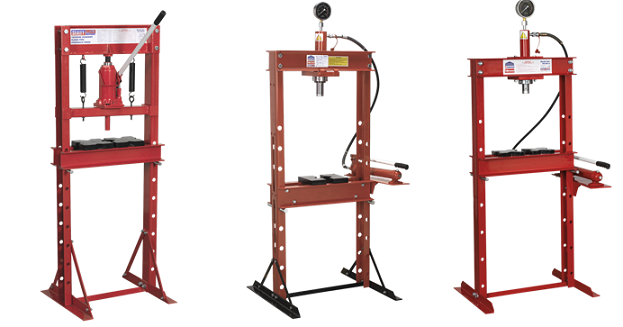
Published - 18th October 2017 / Updated - 26th March 2019
If you work in an industrial environment, you may well have come across a Hydraulic Press before. This piece of equipment is used in a variety of different operations, such as pressing metallic objects into a sheet of metal, thinning glass, crushing cars and making powders. A hydraulic press can be used to suit the needs of most industrial environments.
So, how does a hydraulic press work?
A hydraulic press contains two cylinders which are connected to one another. Each cylinder contains hydraulic fluid and one cylinder is larger than the other. The larger cylinder is known as the Ram and the smaller one is known as the Plunger.
Liquids do not compress easily, which is why they are used in a hydraulic press. The hydraulic press works by pressing a small amount of force onto the Plunger which presses the fluid below. This pressure is then distributed evenly which in turn raises the Ram. The pressure between the Plunger and the Ram then works to crush the item placed between them.
This works due to Pascal's Law which dictates that the pressure in the larger cylinder (the Ram) will stay the same as the pressure in the smaller cylinder (the plunger).
To see a hydraulic press working in action, take a look at the Hydraulic Press Channel which focuses entirely on the crushing power of different hydraulic presses.
What are the benefits of a hydraulic press?
Due to the way hydraulic presses work, they also provide a multitude of different benefits when compared to a mechanical press. Here are just a few benefits of a hydraulic press.
- Lower cost. A hydraulic press is typically much cheaper than a mechanical press due to their simple nature. The original cost is lower and the maintenance cost is also lower due to a smaller amount of breakdowns and it is easier to replace the moving parts within a hydraulic press.
- Overload protection. If you have a 30-ton hydraulic press, this will only ever exert 30 tons of pressure. Or if you set the pressure level for less, it will only release this level of pressure. Once that level is reached, a relief valve is opened which will not allow the hydraulic press to surpass that level.
- Less noise. Because hydraulic presses use less moving pieces, the noise level is reduced. As you have complete control with a hydraulic press, this means you can also control the noise level.
Our Hydraulic Presses:
We offer a range of high-quality hydraulic presses that are made of steel, powder coated, and available with or without gauge depending on your requirements. To buy a hydraulic press, simply click the button below:
Browse Our Full Range of Hydraulic Presses >
If you have any questions about purchasing a hydraulic press from us, don't hesitate to get in touch with our friendly team!
Contact Us

